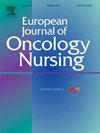Biobehavioral correlates of multidimensional fatigue in men with prostate cancer: A secondary data analysis
IF 2.7
3区 医学
Q1 NURSING
引用次数: 0
Abstract
Purpose
The purpose of this secondary analysis was to 1) examine trajectories of multidimensional cancer-related fatigue (CRF) in men with prostate cancer during and after radiation treatment completion, and 2) identify biobehavioral correlates (demographic, clinical, co-occurring symptoms, and biologic [inflammatory cytokines]) for the different CRF dimensions.
Methods
Data were obtained from a descriptive, longitudinal IRB-approved study investigating the biology of CRF in men with prostate cancer receiving radiation therapy. Data were included from 68 participant medical records, self-report questionnaires, and blood samples. Multidimensional CRF was assessed using the MFSI-SF questionnaire. Data were collected at: baseline (T1), completion of radiation therapy (T2), 6 months (T3) and 24 months (T4) after completion of radiation therapy. Spearman Rank correlations between MFSI-SF subscale scores and patient reported outcomes and biomarker values were computed for each time point.
Results
Most dimensions (general, physical, mental) of CRF worsened during treatment, with the exception of improved emotional fatigue. After treatment completion, most CRF dimensions (general, physical, mental) improved, while emotional fatigue remained steady. During treatment, co-occurring symptoms (anxiety, depression, pain, difficulty sleeping) were each observed to be associated with different CRF dimensions. After treatment completion, prostate cancer risk group, co-occurring symptoms, and IL-8 were observed to be associated with different CRF dimensions.
Conclusion
The findings support that there may be unique correlates, including biologic correlates, for the different dimensions of CRF. Understanding the different dimensions of CRF is critical for development of tailored assessments and interventions targeted to the unique CRF dimensions to optimize management.
前列腺癌患者多维疲劳的生物行为相关性:一项次要数据分析
本次要分析的目的是:1)检查前列腺癌患者放射治疗完成期间和之后的多维癌症相关疲劳(CRF)轨迹;2)确定不同CRF维度的生物行为相关性(人口统计学、临床、共发生症状和生物[炎症细胞因子])。方法数据来自一项经irb批准的描述性纵向研究,该研究调查了接受放射治疗的前列腺癌患者的CRF生物学。数据包括68名参与者的医疗记录、自我报告问卷和血液样本。使用MFSI-SF问卷评估多维CRF。在基线(T1)、放疗结束(T2)、放疗结束后6个月(T3)和24个月(T4)收集数据。计算每个时间点MFSI-SF亚量表评分与患者报告的结果和生物标志物值之间的Spearman Rank相关性。结果治疗期间,除情绪疲劳有所改善外,CRF的一般、生理、心理等各维度均出现恶化。治疗完成后,大多数CRF维度(一般、身体、精神)改善,而情绪疲劳保持稳定。在治疗期间,共发生症状(焦虑、抑郁、疼痛、睡眠困难)均与不同的CRF维度相关。治疗结束后,观察前列腺癌危险组、共现症状、IL-8与不同CRF维度的相关性。结论CRF的不同维度可能存在独特的相关性,包括生物学相关性。了解CRF的不同维度对于制定针对独特CRF维度的量身定制评估和干预措施以优化管理至关重要。
本文章由计算机程序翻译,如有差异,请以英文原文为准。
求助全文
约1分钟内获得全文
求助全文
来源期刊
CiteScore
4.40
自引率
3.60%
发文量
109
审稿时长
57 days
期刊介绍:
The European Journal of Oncology Nursing is an international journal which publishes research of direct relevance to patient care, nurse education, management and policy development. EJON is proud to be the official journal of the European Oncology Nursing Society.
The journal publishes the following types of papers:
• Original research articles
• Review articles

 求助内容:
求助内容: 应助结果提醒方式:
应助结果提醒方式:


